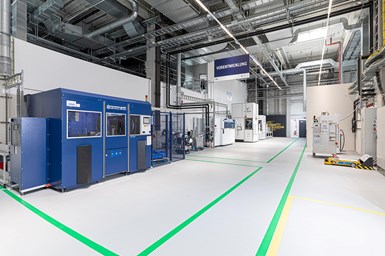Consortium Sets Up Cost-Effective AM Production Lines for Automotive Parts
Automotive parts can now be mass produced using additive manufacturing technology’s laser powder bed fusion for the standard production of cars at two BMW Group sites.
A consortium of 12 project partners has set up two fully automated production lines for the additive series production of automotive parts as part of the Industrialization and Digitization of Additive Manufacturing (IDAM) project. The IDAM project goal was to industrialize and digitize AM to utilize it for the series production of automotive parts.
The project was funded by the German Federal Ministry of Education and Research (BMBF) and led by the BMW Group. Scientists from the RWTH Aachen University Chair Digital Additive Production (DAP) supported the project, particularly in the digital automation of process chains.
After three years of collaboration, the consortium says it has successfully implemented metal 3D printing in the standard production of cars at the BMW Group additive manufacturing (AM) campus in Oberschleißheim. There, a digitally networked, fully automated 3D printing production line has been set up and prepared for automotive series production. Another line is located at GKN Powder Metallurgy in Bonn. Thanks to the new infrastructure, the group says that at least 50,000 components in the same-parts production, and more than 10,000 individual and spare parts can now be cost-efficiently produced at two sites using metallic 3D printing.
The fully automated AM line integrates metallic 3D printing into an automated series process in the automotive industry for the first time and offers a look at the further potential of AM for automotive parts, the consortium says.
At the two BMW Group sites, automotive parts can now be mass produced using AM technology’s laser powder bed fusion (LPBF). In this process, metal powder is melted layer by layer with a laser exactly at the points where the final component will emerge. The advantages are that no specially crafted tools are needed, and the implementation of new design possibilities is more flexible.
The result is a fully automated production line thanks to open vector format (OVF). In just three years, a production line was developed, which performs all necessary work steps via computer-operated control. This means that components can be designed, produced and reworked autonomously. Even the recycling of unused metal powders is automated. Driverless transport systems move raw materials and the final products between individual modules of the production line. The machines are orchestrated by a central control unit, in which all production data of the individual line modules converge.
The Open Vector Format, co-developed by the DAP Chair, is said to make an important contribution to this successful digitization. The consortium says new data format is being used to reliably generate and process manufacturing data for the LPBF process. In IDAM, it is utilized to combine the output of different programs or automated substeps along the process chain across manufacturers and to merge the corresponding data. It is said to thus lay the foundation for the scalable, modular and automatically linked LPBF process chain developed in the project.
To make optimal use of the fully automated process line, the DAP Chair developed software modules for automatic orientation optimization of components. The orientation is said to play an important role in the efficiency, durability and quality of the final component. In addition, in-situ process monitoring and data evaluation were improved by developing AI-based algorithms. Here, too, the OVF was able to support by incorporating metadata.
Related Content
Additive Manufacturing Is Subtractive, Too: How CNC Machining Integrates With AM (Includes Video)
For Keselowski Advanced Manufacturing, succeeding with laser powder bed fusion as a production process means developing a machine shop that is responsive to, and moves at the pacing of, metal 3D printing.
Read MoreActivArmor Casts and Splints Are Shifting to Point-of-Care 3D Printing
ActivArmor offers individualized, 3D printed casts and splints for various diagnoses. The company is in the process of shifting to point-of-care printing and aims to promote positive healing outcomes and improved hygienics with customized support devices.
Read MoreVulcanForms Is Forging a New Model for Large-Scale Production (and It's More Than 3D Printing)
The MIT spinout leverages proprietary high-power laser powder bed fusion alongside machining in the context of digitized, cost-effective and “maniacally focused” production.
Read MoreThis Drone Bird with 3D Printed Parts Mimics a Peregrine Falcon: The Cool Parts Show #66
The Drone Bird Company has developed aircraft that mimic birds of prey to scare off problem birds. The drones feature 3D printed fuselages made by Parts on Demand from ALM materials.
Read MoreRead Next
Alquist 3D Looks Toward a Carbon-Sequestering Future with 3D Printed Infrastructure
The Colorado startup aims to reduce the carbon footprint of new buildings, homes and city infrastructure with robotic 3D printing and a specialized geopolymer material.
Read MorePostprocessing Steps and Costs for Metal 3D Printing
When your metal part is done 3D printing, you just pull it out of the machine and start using it, right? Not exactly.
Read MoreBike Manufacturer Uses Additive Manufacturing to Create Lighter, More Complex, Customized Parts
Titanium bike frame manufacturer Hanglun Technology mixes precision casting with 3D printing to create bikes that offer increased speed and reduced turbulence during long-distance rides, offering a smoother, faster and more efficient cycling experience.
Read More






















